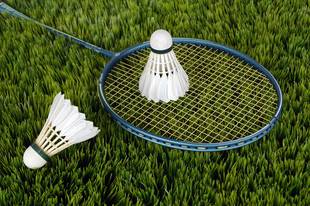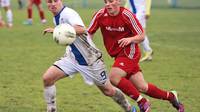
In playing badminton, it is very necessary to learn the different terms used in order to understand the game, especially its rules or laws. The laws that will be learned and discussed here are based from the laws being implemented by the Philippine Badminton Association.
Definition of Terms
Player - Any person playing badminton
Match - The game proper between two opposing sides on a 2 out of 3 games or 3 out of 5 games.
Singles - A match were there is one player on each of the opposing sides.
Doubles - A match where there are two players on each of the opposing sides
Serving side - The side having the right to serve
Receiving side - The side opposing the serving side
Rally - A sequence of one or more strokes starting with the service, until the shuttle ceases to be in play
Laws in Badminton
1. TOSS
1.1 Before play commences, a toss shall be conducted and the side winning the toss shall exercise the choice in either Law 1.1.1 or 1.1.2:
1.1.1 to serve or receive first;
1.1.2 to start play at one end of the court or the other.
1.2 The side losing the toss shall then exercise the remaining choice.
2. SCORING SYSTEM
2.1 A match shall consist of the best of three games, unless otherwise arranged.
2.2 In men's singles and doubles, a game is won by the first side to score 15 points, except as provided in Law 2.5
2.3 In women's singles, doubles and mixed doubles, a game is won by the first side to score 11 points, except as provided in Law 2.5
2.4 Only the serving side can add a point to its score (see Law 5.3 or 6.5)
2.5 If the score becomes 14-all (10-all in women's singles, doubles and mixed doubles), the side which first scored 14 (10) shall choose either Law 2.5 or 2.5.2:
2.5.1 to continue the game to 15 (11) points, ie not to 'set' the game; or
2.5.2 to 'set' the game to 17 (13)points.
2.6 The side winning a game serves first in the next game.
3. CHANGE OF ENDS
3.1 Players shall change ends:
3.1.1 at the end of the first game;
3.1.2 prior to the beginning of the third game (if any); and
3.1.3 in the third game, or in a match of one game, when a side first scores:
- 6 in a game of 11 points; or
- 8 in a game of 15 points.
3.2 If players omit to change ends as indicated in Law 3.1, they shall do so as soon as the mistake is discovered and the shuttle is not in play. The existing score shall stand.
4. SERVICE
4.1 In a correct service.
4.1.1 neither side shall make undue delay to the deliver of the service once a server and receiver have taken their respective positions;
4.1.2 the server and receiver shall stand within diagonally opposite service courts without touching the boundary lines of these service courts;
4.1.3 some parts of both feet of the server and receiver shall remain in contact with the surface of the court in a stationary position from the start of the service (Law 4.4) until the service is delivered (Law 4.5);
4.1.4 the server's racket shall initially hit the base of the shuttle;
4.1.5 the whole shuttle shall be below the server's waist at the instance of being hit by the server's racket;
4.1.6 the shaft of the server's racket at the instance of hitting the shuttle shall be pointing in a downward direction to such an extent that the whole of the head of the racket is discernibly below the whole of the server's hand holding the racket as in Diagram D;
4.1.7 the movement on the server's racket shall continue forward from the start of the service (Law 4.4) until the service is delivered; and
4.1.8 the flight of the shuttle shall be upward from the server's racket to pass over the net so that, if not intercepted, it lands in the receiver's service court (ie on or within the boundary lines).
4.2 If a service is not correct by virtue of any of Laws 4.1.1 to 4.1.8, it shall be a 'fault' (Law 8) by the offending side.
4.3 It is 'fault' if the server, in attempting to serve, misses the shuttle.
4.4 Once the players have taken their positions, the first forward movement of the server's racket head shall be the start of the service.
4.5 Once started (Law 4.4), the service is delivered when the shuttle is hit by the server's racket or, in attempting to serve, the server misses the shuttle.
4.6 The server shall not serve before the receiver is ready, but the receiver shall be considered to have been ready if a return of service is attempted.
4.7 In doubles, the partners may take up any position disadvantageous to the opposing server or receiver.
5. SINGLES
5.1 Serving and receiving courts
5.1.1 The players shall serve from, and receive in, their respective right service courts when the server has not scored or has scored an even number of points in that game.
5.1.2 The players shall serve from, and receive in, their respective left service courts when the server has scored an odd number of points in that game.
5.2 The shuttle is hit alternately by the server and the receiver until a 'fault' is made or the shuttle ceases to be in play.
5.3 Scoring and serving
5.3.1 If the receiver makes a 'fault' or the shuttle ceases to be in play because it touches the surface of the court inside the receiver's court, the server scores a point. The server then serves again from the alternate service court.
5.3.2 If the server makes a 'fault' or the shuttle ceases to be in play because it touches the surface of the court inside the server's court, the server loses the right to continue serving and the receiver then becomes the server, with no point scored by either player.
6. DOUBLES
6.1 At the start of a game, and each time a side gains the right to serve, the service shall be delivered from the right service court.
6.2 Only the receiver shall return the service: should the shuttle touch or be hit by the receiver's partner, it shall be a 'fault' and the serving side scores a point.
6.3 Order of play and position on court
6.3.1 After the services is returned, the shuttle may be hit by either player of the serving side and then by either player of the receiving side. and so on, until the shuttle ceases to be in play.
6.3.2 After the service is returned, a player may hit the shuttle from any position on that player's side of the net.
6.4 Serving and receiving courts
6.4.1 The player who serves at the start of any game shall serve from, or receive in, the right service court when that player's side has not scored or has scored an even number of points in that game, and the left service court when that player's side has scored an odd number of points in that game.
6.4.2 The player who receives at the start of any game shall receive in, or serve from, the right service count when that player's side has not scored or has scored an even number of points in that game, and the left service court when that player's side has scored an odd number of points in that game.
6.4.3 The reverse pattern shall apply to the partners.
6.5Scoring and serving
6.5.1 If the receiving side makes a 'fault' of the shuttle ceases to be in play because it touches the surface of the court inside the receiving side's court, the serving side scores a point and the server serves again.
6.5.2 If the serving side makes a 'fault' of the shuttle ceases to be in play because it touches the surface of the court inside the serving side's court, the server loses the right to continue serving, with no point scored by either side.
6.6 Service in any turn of serving shall be delivered from alternate service courts, except as provided in Law 7 and 9.
6.7 In any game, the right to serve passes consecutively from the initial server to the initial receiver, then to that initial receiver's partner, then to the opponent who is due to serve from the right service court (Law 6.4), then to that player's partner, and so on.
6.8 No player shall serve out of turn, receive out of turn, or receive two consecutive services in the same game, except as provided in Law 7 and 9.
6.9 Either player of the winning side may serve first in the next game, and either player of the losing side may receive the service.
7. SERVICE COURT ERRORS
7.1 A service court error has been made when a player:
7.1.1 has served out of turn;
7.1.2 has served from the wrong service court; or
7.1.3 standing in the wrong service court, was prepared to receive the service and it has been delivered.
7.2 If a service court error is discovered before the next service is delivered:
7.2.1 if one side made the error and won the rally, it shall be a 'let';
7.2.2 if one side made the error and lost the rally, the error shall not be corrected;
7.2.3 if both sides made an error, it shall be a 'let'.
7.3 If there is a 'let' because of a service court error, the rally shall be replayed with the error corrected.
7.4 If a service court error is discovered after the next service has been delivered, the error shall not be corrected as the play in that game shall proceed without changing the player's new service courts (nor, when relevant, the new order of serving).
8. FAULTS
It is a 'fault':
8.1 if a service is not correct (Law 4.1) or if Law 4.3 or 6.2 applies:
8.2 if in play, the shuttle
8.2.1 lands outside the boundaries of the court (ie not on or within the boundary lines);
8.2.2 passes through or under the net;
8.2.3 fails to pass the net;
8.2.4 touches the ceiling or side walls;
8.2.5 touches the person or dress of a player; or
8.2.6 touches any other object or person outside the immediate surroundings of the court;
(Where necessary on account of the structure of the building, the local badminton authority may, subject to the right of veto of its Member Association, make by-laws dealing with cases in which a shuttle touches an obstruction).
8.3 if, when in play, the initial point of contact with the shuttle is not on the striker's side of the net. (The striker, may, however, follow the shuttle over the net with the racket in the course of a stroke);
8.4 If, in play, a player:
8.4.1 touches the net or its supports with racket, person or dress;
8.4.2 invades an opponent's court over the net with racket or person except as permitted in Law 8.3;
8.4.3 invades an opponent's court under the net with racket or person such that an opponent is obstructed or distracted; or
8.4.4 obstructs an opponent, ie prevents an opponent from making a legal stroke where the shuttle is followed over the net;
8.5 if, in play, a player deliberately distracts an opponent by any action such as shouting or making gestures;
8.6 if, in play, the shuttle:
8.6.1 is caught and hold on the racket and then slung during the execution of a stroke;
8.6.2 is hit twice in succession by the same player with two strokes;
8.6.3 is hit by a player and the player's partner successively; or
8.6.4 touches a player's racket and continues towards the back of that player's court;
8.7 if a player is guilty of flagrant, repeated or persistent offenses under Law 6;
8.8 if, on service, the shuttle is caught on the net and remains suspended on top or, on service, after passing over the net, is caught in the net.
9. LETS
9.1 'Let' shall be called by the umpire, or by a player (if there is no umpire), to halt play if:
9.1.1 the server serves before the receiver is ready (see also Law 4.6);
9.1.2 during service, the receiver and server are both faulted;
9.1.3 a shuttle is caught on the net and remains suspended on top or, after passing over the net, is caught in the net, except on service;
9.1.4 a line judge is unsighted and the umpire is unable to make a decision;
9.1.5 a line judge is unsighted and the umpire is unable to make a decision;
9.1.6 a service court error as specified in Law 7.2.1 or 7.2.3 has occured; or
9.1.7 any unforeseen or accidental situation has occured.
9.2 When a 'let' occurs, the play since the last service shall not count and the player who served shall serve again, except where Law 7 is applicable.
10. SHUTTLE NOT IN PLAY
A shuttle is not in play when:
10.1 it strikes the net and remains attached there or suspended on top;
10.2 it strikes the net and starts to fall towards the surface of the court on the striker's side of the net;
10.3 it hits the surface of the court; or
10.4 a 'fault' or 'let' has occured.
11. CONTINUOUS PLAY, MISCONDUCT, PENALTIES
11.1 Play shall be continuous from the first service until the match is concluded, except as allowed in Law 11.2 and 11.3.
11.2 Intervals not exceeding 90 seconds between the first and second games, and not exceeding 5 minutes between the second and third games, shall be allowed in all matches.
11.3 Suspension of play
11.3.1 When necessitated by circumstances not within the control of the players, the umpire may suspend play for such a period as the umpire may consider necessary.
11.3.2 Under special circumstances the Referee may instruct the umpire to suspend play.
11.3.3 If play is suspended, the existing score shall stand and play shall be resumed from that point.
11.4 Delay in play
11.4.1 Under no circumstances shall play be delayed to enable a player to recover strength or wind.
11.4.2 The umpire shall be the sole judge of any delay in play.
11.5 Advice and leaving the court
11.5.1 Except in the intervals provided in Laws 11.2 and 11.3, no player shall be permitted to receive advice during a match.
11.5.2 Except during the five minute interval described in Law 11.2, no player shall have the court during a match without the umpire's permission.
11.6 A player shall not:
11.6.1 deliberately modify or damage the shuttle in order to change its speed or its flight;
11.6.2 behave in an offensive manner; or
11.6.3 be guilty of misconduct not otherwise covered by the Laws of badminton.
11.7 The umpire shall administer any breach of Law 11.4, 11.5 or 11.6 by:
11.7.1 issuing a warning to the offending side;
11.7.2 faulting the offending side, if previously warned; or
11.7.3 in cases of flagrant offense or persistent offenses, faulting the offending side and reporting the offending side immediately to the Referee, who shall have power to disqualify the offending side from the match.
12. OFFICIALS AND APPEALS
12.1 The Referee is in overall in-charge of the tournament or event of which a match forms apart.
12.2 The umpire, where appointed, is in-charge of the match, the court and its immediate surrounds. The umpire shall report to the Referee.
12.3 The service judge shall call service faults made by the server should they occur (Law 4),
12.4 A line judge shall indicate whether a shuttle landed 'in' or 'out' on the line(s) assigned.
12.5 An official's decision is final on all points of fact for which that official is responsible.
12.6 An umpire shall:
12.6.1 uphold and enforce the Laws of badminton and, especially, call a 'fault' or 'let' should either occur;
12.6.2 give a decision on any appeal regarding a point of dispute, if made before the next service is delivered;
12.6.3 ensure players and spectators are kept informed of the progress of the match;
12.6.4 appoint or remove line judges or a service judge in consultation with the Referee;
12.6.5 where another court official is not appointed, arrange for that official's duties to be carried out,
12.6.6 where an appointed official is unsighted, carry out the official's duties or play a 'let';
12.6.7 record and report to the Referee all matters in relation to Law 11; and
12.6.8 take to the Referee all unsatisfied appeals on questions of law only. (Such appeals must be made before the next service is delivered or; if at the end of a game, before the side that appeals has left the court).


















